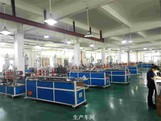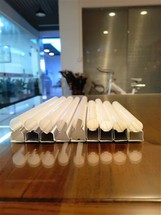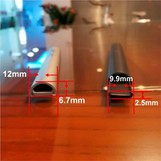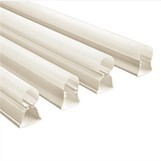In the realm of engineering plastics, Acrylonitrile Butadiene Styrene (ABS) has long been a staple due to its versatility, cost - effectiveness, and ease of processing. As a Modified ABS supplier, I am often asked whether our modified ABS products can be used in high - stress applications. This blog post aims to delve into this question, exploring the properties of modified ABS, its suitability for high - stress scenarios, and how it compares to other materials.
Understanding Modified ABS
Before we discuss high - stress applications, it's essential to understand what modified ABS is. ABS is a terpolymer made up of acrylonitrile, butadiene, and styrene. Each component contributes unique properties: acrylonitrile provides chemical resistance and heat stability, butadiene offers toughness and impact resistance, and styrene gives the material rigidity and processability.
Modified ABS involves altering the base ABS polymer through various means, such as adding fillers, reinforcements, or additives. These modifications are designed to enhance specific properties of the material to meet the requirements of different applications. For instance, Reinforced Modified ABS is created by adding glass fibers or other reinforcements to improve its strength and stiffness. Heat Resistance Grade ABS contains additives that boost its ability to withstand high temperatures without deforming. And Weather Resistant ABS is formulated to resist the effects of UV radiation, moisture, and other environmental factors.
Properties of Modified ABS Relevant to High - Stress Applications
Strength and Stiffness
One of the most critical factors in high - stress applications is the material's strength and stiffness. Reinforced Modified ABS can have significantly improved mechanical properties compared to standard ABS. Glass - fiber reinforced ABS, for example, can have a tensile strength that is two to three times higher than that of non - reinforced ABS. This increase in strength allows the material to withstand higher loads without breaking or deforming plastically.


The stiffness of modified ABS is also enhanced through reinforcement. A higher modulus of elasticity means that the material will deform less under a given load, which is crucial in applications where dimensional stability is required. For example, in automotive components such as engine covers or structural brackets, a stiff material is needed to maintain its shape and function under the high stresses generated by the engine's operation.
Impact Resistance
High - stress applications often involve sudden or dynamic loads, which require a material with good impact resistance. Modified ABS retains the inherent impact resistance of the base ABS polymer and can be further enhanced through modification. The butadiene component in ABS acts as a toughening agent, absorbing energy during an impact and preventing crack propagation.
In some cases, additives can be used to improve the low - temperature impact resistance of modified ABS. This is particularly important in applications where the material may be exposed to cold environments, such as outdoor machinery or aerospace components. A material that can withstand impacts at low temperatures is less likely to fail suddenly, ensuring the safety and reliability of the application.
Fatigue Resistance
Fatigue is a major concern in high - stress applications where the material is subjected to repeated loading. Modified ABS can exhibit good fatigue resistance, especially when properly formulated. The addition of reinforcements and additives can help distribute the stress more evenly throughout the material, reducing the likelihood of fatigue cracks forming.
For example, in the manufacture of sports equipment such as bicycle frames or ski bindings, the material must be able to withstand thousands of cycles of loading without failing. Modified ABS with good fatigue resistance can provide a cost - effective alternative to more expensive materials like carbon fiber composites while still meeting the performance requirements.
High - Stress Applications Where Modified ABS Can Be Used
Automotive Industry
The automotive industry is a prime example of an area where modified ABS is used in high - stress applications. In the interior of a vehicle, components such as dashboard frames, door handles, and seat brackets are subjected to various stresses during normal use. Modified ABS can provide the necessary strength, stiffness, and impact resistance to ensure these components function properly and safely.
Under the hood, where temperatures are high and mechanical stresses are significant, Heat Resistance Grade ABS can be used for components such as air intake manifolds, engine covers, and wiring harness connectors. These parts need to withstand the heat generated by the engine as well as the vibrations and mechanical forces associated with engine operation.
Electronics and Electrical Equipment
In the electronics and electrical equipment industry, modified ABS is used in high - stress applications such as computer housings, power tool casings, and electrical connectors. These components need to protect the internal electronics from physical damage and environmental factors while also withstanding the stresses associated with assembly, installation, and use.
The strength and stiffness of modified ABS make it suitable for providing structural support to the delicate electronic components inside. Additionally, its good electrical insulation properties ensure that it can be used safely in electrical applications.
Aerospace Industry
Although the aerospace industry typically uses high - performance materials such as titanium and carbon fiber composites, modified ABS can still find applications in certain high - stress areas. For example, in non - critical interior components such as overhead bins, seat armrests, and cabin panels, modified ABS can provide a lightweight and cost - effective solution.
The impact resistance and fire - retardant properties of modified ABS can be tailored to meet the strict safety requirements of the aerospace industry. While it may not be suitable for primary structural components, it can contribute to the overall functionality and comfort of the aircraft interior.
Comparison with Other Materials
When considering using modified ABS in high - stress applications, it's important to compare it with other materials commonly used in these scenarios.
Steel
Steel is known for its high strength and stiffness, making it a popular choice for high - stress applications. However, steel is much heavier than modified ABS, which can be a disadvantage in applications where weight reduction is a priority, such as automotive and aerospace industries. Modified ABS can offer a comparable level of strength and stiffness at a fraction of the weight, resulting in improved fuel efficiency and performance.
Aluminum
Aluminum is another lightweight metal commonly used in high - stress applications. It has good corrosion resistance and is relatively easy to machine. However, aluminum can be more expensive than modified ABS, especially when considering the cost of raw materials and manufacturing processes. Modified ABS can provide a cost - effective alternative with similar mechanical properties in some applications.
Carbon Fiber Composites
Carbon fiber composites are extremely strong and lightweight, making them ideal for high - performance applications. However, they are also very expensive and require specialized manufacturing processes. Modified ABS can be a more practical choice for applications where the performance requirements are not as extreme and cost is a major consideration.
Conclusion
In conclusion, modified ABS can indeed be used in high - stress applications. Its properties, such as strength, stiffness, impact resistance, and fatigue resistance, can be tailored through modification to meet the specific requirements of different applications. The automotive, electronics, and aerospace industries are just a few examples of areas where modified ABS is already being used successfully in high - stress scenarios.
As a Modified ABS supplier, we are committed to providing high - quality products that meet the diverse needs of our customers. Our team of experts can work with you to develop customized modified ABS solutions for your high - stress applications. Whether you need a material with enhanced strength, heat resistance, or impact resistance, we have the knowledge and experience to deliver the right product.
If you are interested in learning more about our Modified ABS products or discussing potential applications, please feel free to contact us. We look forward to the opportunity to work with you and help you find the best material solution for your high - stress applications.
References
- "Engineering Plastics: Properties and Applications" by Charles A. Harper.
- "Plastics in Automotive Engineering" by Peter K. Mallick.
- "Handbook of Polymer Science and Technology" edited by Herman F. Mark.




